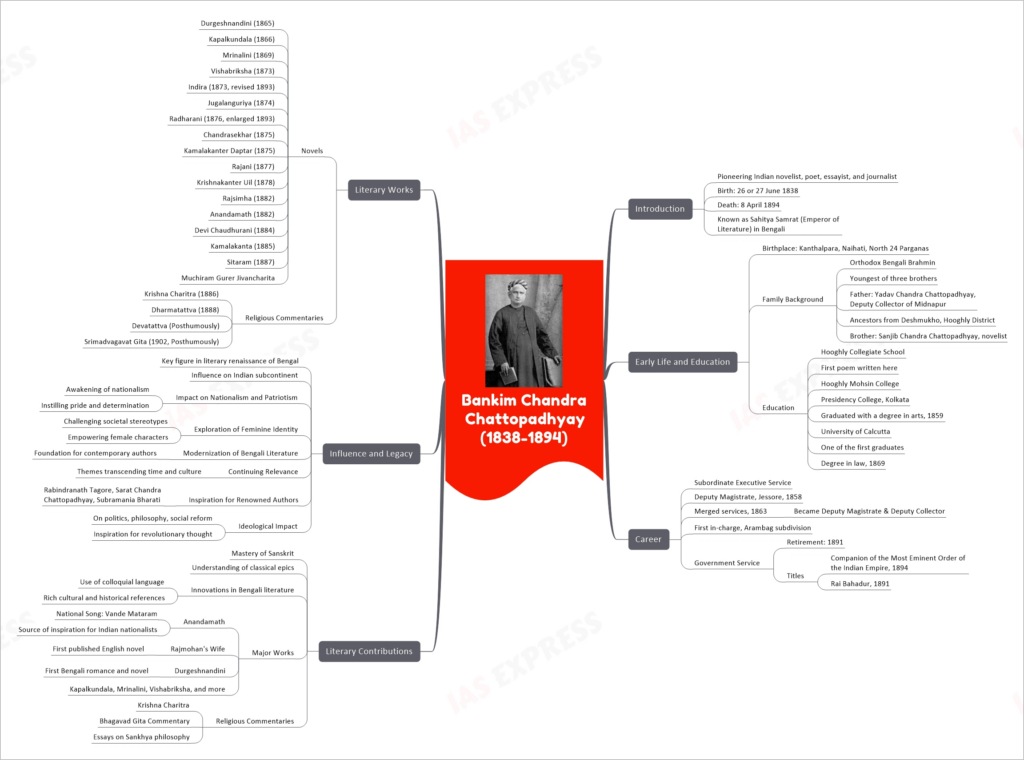Bankim Chandra Chattopadhyay (1838-1894): The Literary Giant of Bengal
This topic of “Bankim Chandra Chattopadhyay (1838-1894): The Literary Giant of Bengal” is important from the perspective of the UPSC IAS Examination, which falls under General Studies Portion.
Introduction
Bankim Chandra Chattopadhyay, a name that resonates with literary excellence, was a multifaceted Indian personality who made remarkable contributions as a novelist, poet, essayist, and journalist. Born on either the 26th or 27th of June in 1838, he left an indelible mark on the literary and cultural landscape of India before his demise on April 8, 1894. Often referred to as “Sahitya Samrat” or the “Emperor of Literature” in Bengali, his life and works continue to inspire generations.
Early Life and Education
- Birthplace: Bankim Chandra Chattopadhyay was born in Kanthalpara, Naihati, North 24 Parganas, India.
- Family Background: He hailed from an orthodox Bengali Brahmin family. He was the youngest of three brothers, with his father, Yadav Chandra Chattopadhyay, serving as the Deputy Collector of Midnapur. His ancestors hailed from Deshmukho, Hooghly District, adding to the rich cultural tapestry of his upbringing. Notably, his brother, Sanjib Chandra Chattopadhyay, also achieved fame as a novelist.
- Education: Bankim Chandra’s academic journey included stints at Hooghly Collegiate School, where he penned his first poem. He furthered his education at Hooghly Mohsin College, Presidency College in Kolkata, and eventually graduated with a degree in arts in 1859 from the University of Calcutta. He also obtained a degree in law in 1869.
Career
- Subordinate Executive Service: He embarked on his career as a Deputy Magistrate in Jessore in 1858.
- Merged Services: In 1863, he merged services and held the dual role of Deputy Magistrate and Deputy Collector. He also served as the first in-charge of the Arambag subdivision.
- Government Service: Bankim Chandra Chattopadhyay retired from government service in 1891, having achieved titles like “Companion of the Most Eminent Order of the Indian Empire” in 1894 and “Rai Bahadur” in 1891.
Literary Contributions
- Mastery of Sanskrit: Bankim Chandra had a deep understanding of Sanskrit, which greatly influenced his literary works.
- Innovations in Bengali Literature: He brought significant innovations to Bengali literature, incorporating colloquial language and infusing his writings with rich cultural and historical references.
- Major Works:
- Anandamath: This work is famous for giving birth to the national song, “Vande Mataram,” which became a source of inspiration for Indian nationalists.
- Rajmohan’s Wife: It is notable as the first published English novel.
- Durgeshnandini: This novel marked the beginning of Bengali romance literature.
- Kapalkundala, Mrinalini, Vishabriksha, and many more.
- Religious Commentaries:
- Krishna Charitra
- Bhagavad Gita Commentary
- Essays on Sankhya philosophy
Influence and Legacy
- Key Figure in Literary Renaissance: Bankim Chandra played a pivotal role in the literary renaissance of Bengal.
- Impact on Nationalism and Patriotism: His works awakened the spirit of nationalism in India, instilling pride and determination among the masses.
- Exploration of Feminine Identity: He challenged societal stereotypes and empowered his female characters, setting a precedent for feminist literature.
- Modernization of Bengali Literature: His contributions laid the foundation for contemporary Bengali authors.
- Continuing Relevance: The themes explored in his works continue to transcend time and culture.
- Inspiration for Renowned Authors: Bankim Chandra Chattopadhyay’s influence extended to luminaries like Rabindranath Tagore, Sarat Chandra Chattopadhyay, and Subramania Bharati.
- Ideological Impact: His writings left an indelible mark on politics, philosophy, and social reform, serving as a wellspring of revolutionary thought.
List of Literary Works
Novels
- Durgeshnandini (1865)
- Kapalkundala (1866)
- Mrinalini (1869)
- Vishabriksha (1873)
- Indira (1873, revised 1893)
- Jugalanguriya (1874)
- Radharani (1876, enlarged 1893)
- Chandrasekhar (1875)
- Kamalakanter Daptar (1875)
- Rajani (1877)
- Krishnakanter Uil (1878)
- Rajsimha (1882)
- Anandamath (1882)
- Devi Chaudhurani (1884)
- Kamalakanta (1885)
- Sitaram (1887)
- Muchiram Gurer Jivancharita
Religious Commentaries
- Krishna Charitra (1886)
- Dharmatattva (1888)
- Devatattva (Posthumously)
- Srimadvagavat Gita (1902, Posthumously)
Conclusion
In conclusion, Bankim Chandra Chattopadhyay stands as a luminary in Indian literature, leaving an indelible mark on the Bengali and Indian cultural landscape. His innovative approach to storytelling, commitment to cultural and historical authenticity, and profound influence on subsequent generations of writers and thinkers solidified his place as an enduring figure in the annals of Indian literature. His literary legacy continues to inspire and shape the cultural and ideological landscape of India, making him a revered icon in the world of literature.


